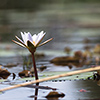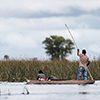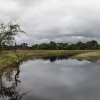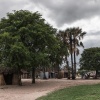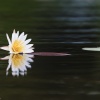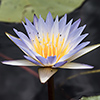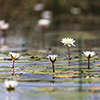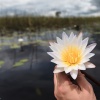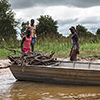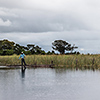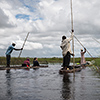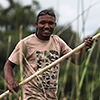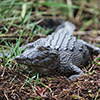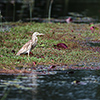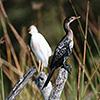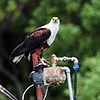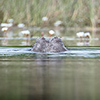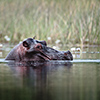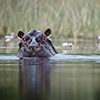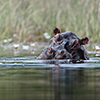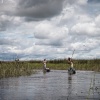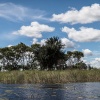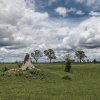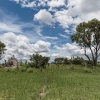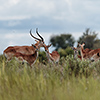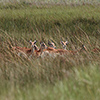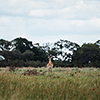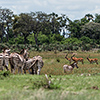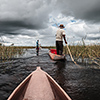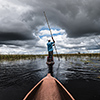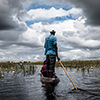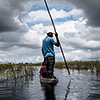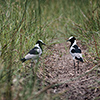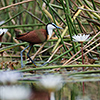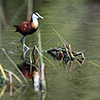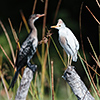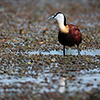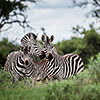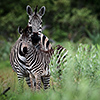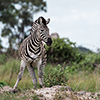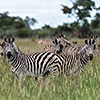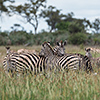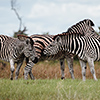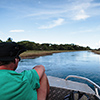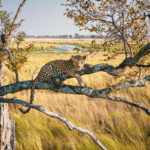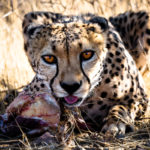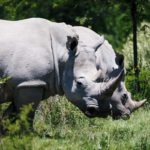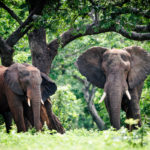Okavango Delta – The Course of River and Time
In March 2003 the city of Maun used to be a village, but now, 12 years later, it’s a town, even Botswana’s third largest town. Without interruption the sky above Okavango Delta, that locals refer to only as The Delta, gets cut by airplanes carrying hundreds of tourists that want to see what the Delta looks like from above. From time to time even jets mingle with the crowd of planes as African Maun even has an international airport; an opened and properly operating international airport, something that we Berliner’s can only dream of until 2018.
Maun is also end of the line for a fellow traveller. Before embarking she said her abilities to stay in the bush are excellent, well, while staying in the bush I noticed that they are not. Living in the bush means a challenge for all things called improvisation skills, mutual help and readiness to compromise. Boasting impairs first and foremost other people and not only oneself, so I’ve put an end to our joint journey. On the way through Makgadikgadi and Nxai Pans towards Maun I notice black heavy clouds, what doesn’t appear as good omen for the Okavango Delta…
I drive to the lagoons of Etsha (pronounced Et’sa) that is a little further to the west of Maun and where I’ve been 12 years ago to access the Okavango Delta. Now the site around Etsha 13 camp is private property. Having arrived that area the owner sends me back in a pretty arrogant way as some fat Yankee rented the whole place to spend Christmas and New Year. To me that means a return trip of 30 kilometres at max 8-9 km/h. Wonderful! Before abandoning the field I have a look around though and find a place to stay overnight with locals.
The western edge region of the delta is surprisingly dry at this time of the year, meaning Okavango doesn’t carry all too much water, what provides additional living space to myriads of little red ants. Also the polers are not too happy about the lack of water as from the Etsha side they cannot embark into the centre of the Okavango Delta since it’s too dry for the small channels. The polers would have to push their boats through very muddy draws. Of course I don’t insist on such a silly feat and return to Maun to get into the delta.
Maybe it is Maun, maybe it is also the touristic development of the past years that let Mokoro rides (a daytrip aboard a local dugout) become a standardised product like a bag of jellybeans. Of course that doesn’t permit much space to all things called creativity as you’re captured in a chain of tourist boats. I have to share my ride with a US-American and a Russian woman. Latter one is pretty talkative person chattering the whole day like a magpie to my as well as the polers’ sorrow.
To crown it all she even answered a half-hour call from Russia right in the Okavango Delta. Cell phone reception in the middle of nowhere, how gross is that? Also in that case a lot happened; from my point of view even too much happened as technical progress literally conquered Africa destroying natural human behaviour by providing a fake online life. It’s great to have the opportunity to call help in case something happened but seeing radio masts spoiling the wild landscapes only to provide Facebook junkies to post every fart they blow while trying to make a selfie walking through the bush like the undead.
That raises the question what such victims are travelling for? Is it to see the world with own eyes or is it to produce a public image? Of course I am using Facebook as well and take photos of myself, but I don’t do that by every breath I take. One time a week is alright to show family and friends back home that I am still alive. The most awesome onliners are the ones running around with an iPhone only but calling themselves wildlife photographer :-) Well, maybe I am the problem here as such people I can’t take serious at all.
Like mentioned initially it is rainy season. Cloudy weather, the flat landscape as well as the even flatter perspective of being nailed down to a boat that floats barely above the water surface, all that doesn’t really provide the ingredients for a photographer’s top shot, though the thick black rain-ladden clouds break up from time to time permitting blue sky and sunlight to peep through. I would have never thought to get an untypical but potent Mokoro ride photo under such conditions.
All is good in that photo: posing, light, dramatic clouds. Suddenly my boat stops as my poler spotted red Lechwe antelopes, a waterbuck-like species, in the far distance. Those very shy animals escape already at the merest sign of human activity and are hardly to see in the high grass.
Drifting along the channels through the Delta our boats startle an army of Blacksmith lapwings and African jacanas. Locals call the latter one Jesus bird as by the help of water lily leafs it can walk over water like the saviour. Along the way we get to see an African fish eagle, a young crocodile and a hippo, that is a bit of a loner bull blocking our way.
Hence we have to walk over land where we bump into grazing zebras and Lechwe antelopes again. Despite a more or less cloud covered sky temperatures are humid and scorching causing air to swirl. That so called mirage is no photographer’s friend as it blurs all shapes being more far away than 100 metres.
Then it’s time to go back again as the Mokoro Day Trip product has reached its predefined end; a product also having a predefined route and doing, though the price you pay doesn’t reach the person doing the actual service as the polers per ride and day only get 5 US$ from 90 bucks being actually paid. They get utilised and exploited by their own people, blacks.
